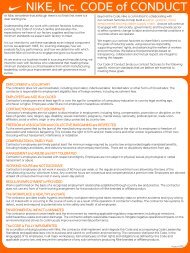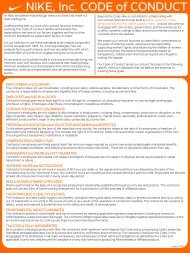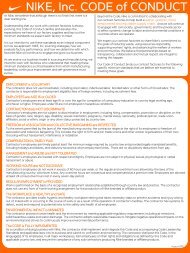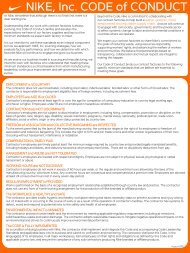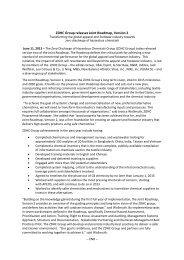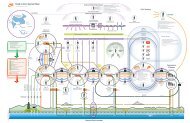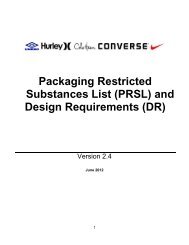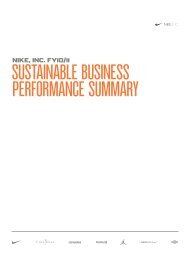COC CLS - Healthy Safety Environment - NIKE, Inc. - The Journey
COC CLS - Healthy Safety Environment - NIKE, Inc. - The Journey
COC CLS - Healthy Safety Environment - NIKE, Inc. - The Journey
You also want an ePaper? Increase the reach of your titles
YUMPU automatically turns print PDFs into web optimized ePapers that Google loves.
HEAT STRESS MANAGEMENT<br />
STANDARD<br />
<strong>The</strong> contractor provides a safe, hygienic and healthy workplace setting and takes necessary steps to<br />
prevent accidents and injury arising out of, linked with or occurring in the course of work or as result of<br />
the operation of contractor’s facilities. <strong>The</strong> contractor has systems to detect, avoid and respond to<br />
potential risks to the safety and health of all employees.<br />
‣ Develop and implement processes and procedures to reduce or eliminate risk associated with<br />
heat stress in the work environment. Contractor must comply with requirements as outlined in<br />
this standard or relevant local laws and regulations, whichever is more stringent.<br />
RESPONSIBILITIES<br />
Location Manager must ensure that the heat stress standard and the procedures are developed,<br />
implemented and followed.<br />
HSE Representative must establish, maintain and administer the heat stress standard and procedures.<br />
Managers & Supervisors must ensure that employees are trained and adhere to the requirements of the<br />
heat stress standard and procedures.<br />
Employees must adhere to the requirements of the heat stress standard and procedures.<br />
DEFINITIONS<br />
• Heat Stress is the general name for several medical conditions such as heat exhaustion, heat<br />
cramps (muscle pain or spasms) and heat stroke, caused by working in hot areas.<br />
• Acclimatization is the body’s adaptation to working in the heat.<br />
REQUIREMENTS<br />
1. POLICIES & PROCEDURES—Each facility must have implemented procedures to reduce or eliminate<br />
the risk associated with heat induced illnesses and injuries, which includes as a minimum:<br />
a. Developing and implementing a written Heat Stress Prevention Program, to include:<br />
• Designating responsibilities for the program.<br />
• Determining when the program should be implemented.<br />
• Creating control measures used to eliminate or reduce risks.<br />
• Selecting and distributing protective clothing.<br />
• Determining work practices used to eliminate or reduce the risk, including:<br />
- Water replenishment during the shift as needed.<br />
- Employee access to shade at all times for preventative recovery periods.<br />
- Responding to symptoms of possible heat illness.<br />
- Contact provisions for emergency medical services.<br />
• Training requirements.<br />
<strong>Safety</strong> <strong>CLS</strong> – Page 1<br />
04.14.10



